 For “Travel Tuesday”, let’s visit Matagorda, TX:
For “Travel Tuesday”, let’s visit Matagorda, TX:
“Matagorda is near the Colorado River mouth and East Matagorda and Matagorda bays, on State Highway 60 and the Atchison, Topeka and Santa Fe line in southern Matagorda County.
If you are looking for a hot fishing spot, a fun day at the beach, a leisure kayaking trip down the Colorado River, or a chance to view a multitude of shore birds, then come on down to Matagorda County.”
HISTORY: “From the beginning, cotton was important; a gin was in operation in the area as early as 1825. Matagorda was incorporated in 1830, and by 1832 it had some 1,400 residents; there were an additional 250 people living outside the town but within its jurisdiction. Beginning in the 1830s, the town, then the closest port city to New Orleans, served as  an entry point for immigrants arriving both overland and by sea. A Mexican customhouse was established in 1831, and a chamber of commerce was in operation by 1840. James H. Selkirk constructed one of the first dock-and-warehouse businesses in the town, and freight moved along the Colorado River despite a raft of logs and debris that impeded river passage. The raft was successfully removed in 1929, but until then water behind it was used for irrigation, and the threat of Colorado River flooding remained.
an entry point for immigrants arriving both overland and by sea. A Mexican customhouse was established in 1831, and a chamber of commerce was in operation by 1840. James H. Selkirk constructed one of the first dock-and-warehouse businesses in the town, and freight moved along the Colorado River despite a raft of logs and debris that impeded river passage. The raft was successfully removed in 1929, but until then water behind it was used for irrigation, and the threat of Colorado River flooding remained.
 During the Civil War, Matagorda was one of eight Texas ports used by blockade runners who removed tons of cotton and delivered guns, munitions, clothing, and other goods to the Confederacy. A blockade interrupted trade, and federal soldiers fired at the town, but none came ashore. Matagorda residents formed several militia groups, among them the Matagorda Coast Guards. The conflict reduced trade, emancipation brought an end to the plantation economy, and Matagorda declined.
During the Civil War, Matagorda was one of eight Texas ports used by blockade runners who removed tons of cotton and delivered guns, munitions, clothing, and other goods to the Confederacy. A blockade interrupted trade, and federal soldiers fired at the town, but none came ashore. Matagorda residents formed several militia groups, among them the Matagorda Coast Guards. The conflict reduced trade, emancipation brought an end to the plantation economy, and Matagorda declined.
After the war, farmers turned to cattle raising. A burgeoning beef industry  led to the establishment of the Stabler Patent Beef Packing Plant in 1866 and a hide and tallow factory in 1870. Ranchers and a few remaining planters kept homes in town. The community was repeatedly damaged by hurricanes, including those in 1875, 1886, and 1894; these storms were partly responsible for the changing of the county seat to Bay City in 1894. Until that year, several factories, the Morgan Lines, and river transportation had made Matagorda an important port; after 1894 it remained a market for cotton, cattle, and fruit. The Cane Belt Railroad reached the town around 1901.”
led to the establishment of the Stabler Patent Beef Packing Plant in 1866 and a hide and tallow factory in 1870. Ranchers and a few remaining planters kept homes in town. The community was repeatedly damaged by hurricanes, including those in 1875, 1886, and 1894; these storms were partly responsible for the changing of the county seat to Bay City in 1894. Until that year, several factories, the Morgan Lines, and river transportation had made Matagorda an important port; after 1894 it remained a market for cotton, cattle, and fruit. The Cane Belt Railroad reached the town around 1901.”
____________
Matagorda is Famous for Fishing, Fresh and Saltwater
“Go Fish! With over 50 miles of shoreline along the Gulf of Mexico and hundreds of miles of waterfront along creeks, rivers and bays, Matagorda is a fisherman's paradise. Cast your line from the beach or wade in to catch redfish and trout, plentiful year-round. Other in-shore species include catfish, mullet, black drum, snook and whiting. If deep-sea fishing is your passion, fish the Gulf for grouper, red snapper, amberjack, kingfish and shark.”
 “The Matagorda Bay system is divided into East Matagorda Bay and West Matagorda Bay by what was the Colorado River. The true river now has been diverted into West Matagorda Bay and continues to build an ever changing environment there. The shorelines of both East and West bays frequently produce above average stringers of trout and redfish. With firm sand bottoms these grassy shoreline are a waders paradise, tossin' a top water lure or a gold spoon among the flats waiting for that rod bending strike from a monster red or trout. Another favorite technique is live lining croaker or finger mullet around the numerous oyster beds found in east or west bay...This often results in great hits from trophy trout....be ready for a super fight!!
“The Matagorda Bay system is divided into East Matagorda Bay and West Matagorda Bay by what was the Colorado River. The true river now has been diverted into West Matagorda Bay and continues to build an ever changing environment there. The shorelines of both East and West bays frequently produce above average stringers of trout and redfish. With firm sand bottoms these grassy shoreline are a waders paradise, tossin' a top water lure or a gold spoon among the flats waiting for that rod bending strike from a monster red or trout. Another favorite technique is live lining croaker or finger mullet around the numerous oyster beds found in east or west bay...This often results in great hits from trophy trout....be ready for a super fight!!
 Another technique to try is "bird chasing" on either bay. Stacking up over a feeding frenzy of trout, feeding seagulls are sure-fire indicator of trout below. Limits of legal size trout can be had with a few short drifts through these areas while free shrimping shrimp, croaker or mullet behind the boat awaiting the swift strike that will be coming shortly. If you grow tired of reeling in trout throughout the bays and are looking for some familiar jetty or surf action.
Another technique to try is "bird chasing" on either bay. Stacking up over a feeding frenzy of trout, feeding seagulls are sure-fire indicator of trout below. Limits of legal size trout can be had with a few short drifts through these areas while free shrimping shrimp, croaker or mullet behind the boat awaiting the swift strike that will be coming shortly. If you grow tired of reeling in trout throughout the bays and are looking for some familiar jetty or surf action.
Beginning with mid summer and its light southeast winds, the surf action around these parts are among the best found along the gulf coast. Along the beaches on either side of the Colorado mouth hold larger sow trout and the bull reds. With a few casts of a broken back or heavy spoon out along the second or third sand bar, you may not have to wait long before a hook up with one of these much sought after fish. With strong currents in the area tend to make the fight that much more difficult and any angler braving the waters would be wise to be wearing a good life jacket. Remember, safety first!
Another great aspect of fishing the Matagorda system is its close proximity to deep water just offshore. Unlike the over trafficked Galveston area just down the coast, the waters just a few miles off the coast of Matagorda are deep and blue, with a wide variety of offshore species of game fish waiting to be caught.”
___________
MATAGORDA FISHING
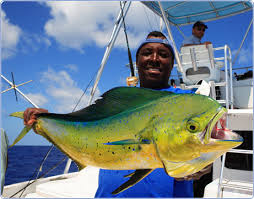 “They catch fish in Matagorda. The big beautiful Matagorda Bay is teeming with speckled trout and red fish. The offshore action is fast and furious.
“They catch fish in Matagorda. The big beautiful Matagorda Bay is teeming with speckled trout and red fish. The offshore action is fast and furious.
Blast through the pass and head for a full day of Matagorda deep sea fishing action.
Big bull dolphin, wahoo, smoking king fish, amber jack and school cobia make the reels sing when you go offshore fishing at Matagorda.
Wrecks, reefs and oil rigs are big attractors for game fish and the schools of fish they attack.
Matagorda Bay fishing primarily means speckled trout, red fish and flounder and sheepshead. There are plenty of fish in the big bay and iOutdoor captains know where they are.
Inshore fishing at Matagorda may mean drifting across grass or shell flats, or wading and casting from the water. Guides and captains use live and dead shrimp, crabs, lures and corkies. Popping corks can be very productive. The system of bays, creeks, coves and cuts produces some of the best fishing in Texas.”
_____________
Birding trips are available.
The Matagorda Bay is also know for fine duck hunting.
______________
Matagorda Island Wildlife Management Area

Matagorda Island Lighthouse and cemetery.
“Matagorda Island Wildlife Management Area covers 56,688 acres and is managed jointly by the Texas Parks & Wildlife Department and U.S. Fish & Wildlife Service as a crucial sanctuary for migratory bird species. Nineteen state or federally-protected species inhabit Matagorda Island, including whooping cranes and peregrine falcons. More than 300 bird species have been noted in the area.
Officially designated the Matagorda Island National Wildlife Refuge and State Natural Area, the island is isolated and free of "modern conveniences" such as electricity, water or telephone service. Visitors are rewarded with opportunities for primitive camping, hiking, seasonal hunting, fishing,  bicycling, birding, swimming, wildlife observation and nature study. A kayak trail, self-guided nature trail and the historic Matagorda Island Lighthouse (28.337889° Latitude, -96.42408° Longitude) are accessible to visitors. Additionally, all 38 miles of beach and 32 miles of paved roads are accessible to hikers and bicyclists on the island. Camping is restricted to designated campsites, which are available on a first come, first served basis (no reservations available.)
bicycling, birding, swimming, wildlife observation and nature study. A kayak trail, self-guided nature trail and the historic Matagorda Island Lighthouse (28.337889° Latitude, -96.42408° Longitude) are accessible to visitors. Additionally, all 38 miles of beach and 32 miles of paved roads are accessible to hikers and bicyclists on the island. Camping is restricted to designated campsites, which are available on a first come, first served basis (no reservations available.)
 In addition to abundant bird species, numerous snake and reptile species also occur on the island, as well as more common wildlife such as white-tail deer, javelina, coyote, raccoon, and jackrabbit. Bottlenose dolphins may be seen during the boat trip to the island. Fishing the waters surrounding the island may yield red drum, spotted sea trout, tarpon, shark and mackerel.
In addition to abundant bird species, numerous snake and reptile species also occur on the island, as well as more common wildlife such as white-tail deer, javelina, coyote, raccoon, and jackrabbit. Bottlenose dolphins may be seen during the boat trip to the island. Fishing the waters surrounding the island may yield red drum, spotted sea trout, tarpon, shark and mackerel.
Visitors to the island should be completely self-sufficient. Bring plenty of drinking water, food, adequate sun protection, and insect repellent. Check weather and tide conditions and forecasts and plan accordingly. Absolutely no private aircraft or motorized vehicles are allowed on the island. Download a Park Map
- “There is no electricity, concession, or drinking water on the island. All visitors are required to bring all necessary supplies with them.
- All interior access is via hiking, biking, or TPWD vehicles during scheduled hunts or tours. No private motorized vehicles!
- Special Note: Persons can continue to utilize the Sunday Beach area, accessed via boat from either the Gulf or Pass Cavallo, for camping, beach combing, fishing, and bird watching. There are no fees, permits, or restrictions on the use of this area.”
___________
For Those Who Want Hook-ups:
 “Matagorda Bay Nature Park is a 1,600-acre park and preserve at the mouth of the Colorado River on the Matagorda Peninsula. LCRA developed the park to provide recreation, education, wetlands preservation and economic benefit to the region.
“Matagorda Bay Nature Park is a 1,600-acre park and preserve at the mouth of the Colorado River on the Matagorda Peninsula. LCRA developed the park to provide recreation, education, wetlands preservation and economic benefit to the region.
The park has about two miles of Gulf of Mexico and two miles river frontage and hundreds of acres of coastal marshes and dunes. It is one of the best birding areas in the nation. LCRA acquired the property in 2001 as part of its commitment to preserve natural resources for future generations and to provide science education, recreation and nature tourism opportunities.”
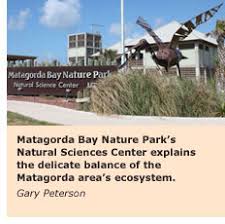 The Natural Sciences Center is located there, too: http://www.lcra.org/library/media/public/docs/parks/matagordabaynaturepark_programscatalog.pdf
The Natural Sciences Center is located there, too: http://www.lcra.org/library/media/public/docs/parks/matagordabaynaturepark_programscatalog.pdf
Campsites
• 22 General Camping Sites: These sites back up to FM 2031, located adjacent to the RV Park. These sites have both 30/50 amp electrical service, sewer connections and a picnic table.
• 5 Pull-Through Sites: Located on the interior roads of the park, these pull-through sites have an obstructed view of the river, have both 30/50 amp electrical service, sewer connections and a picnic table.
• 24 Preferred Sites: Located on the the interior roads of the park, these sites have an obstructed view of the river, have both 30/50 amp electrical service, sewer connections and a picnic table.
• 19 Waterfront Camping Sites: Located on the waterfront, these sites have both 30/50 amp electrical service, sewer connections and a picnic table.
Relax on the beach at Matagorda Bay Nature Park
View park photo slideshow at: http://www.lcra.org/library/media/public/slideshows/parks_slideshows/matagorda_bay/index.html
__________
Other Things to Do:
 “Golfers of all levels will find a challenging course at the Rio Colorado Golf Course. Rio is an 18-hole public course featuring a championship layout built along the Colorado River. Golfers can also sharpen their game at the Palacios Golf Course, a 9-hole public facility. For more information and reservations, call the Rio Colorado Golf Course at (979) 244-2955. Call the Palacios Golf Course at (361) 972-5947.
“Golfers of all levels will find a challenging course at the Rio Colorado Golf Course. Rio is an 18-hole public course featuring a championship layout built along the Colorado River. Golfers can also sharpen their game at the Palacios Golf Course, a 9-hole public facility. For more information and reservations, call the Rio Colorado Golf Course at (979) 244-2955. Call the Palacios Golf Course at (361) 972-5947.
For a relaxing day of shopping, Matagorda County offers a great selection of stores. Hot-spots include Palacios' Main Street, Bay City's Historic  Downtown Square and the village of Matagorda.
Downtown Square and the village of Matagorda.
Take a cruise on R.V. Karma and learn about the exciting natural world around you. The Karma is a 57-foot teaching and research vessel, offering students of all ages a rare opportunity to explore the Gulf Coast's natural environment. Public cruises are offered on the first Saturday of each month. Call 361-825- 3460 for more information and reservations.
3460 for more information and reservations.
Paddle a kayak down the Colorado River or weave through the saltwater marshes along the Gulf. Whichever path you choose, you'll enjoy a relaxing way to experience the water and its surrounding wildlife.
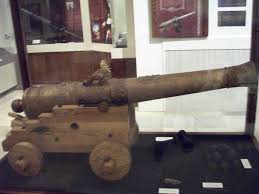

The past comes alive at the Matagorda County Museum. Exhibits include artifacts from the Karankawa Indians, cannon from 17th-century French explorer LaSalle's ship La Belle and more. The Children's Museum on the lower level features a recreation of an early 20th-century Texas town where kids can "shop" at an old-fashioned general store, dress up in period costume, and interact with the past.”
____________
The Runways at Matagorda Island 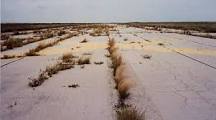
“This abandoned airfield is located on a narrow island on the Gulf of Mexico. The airfield was labeled as "Matagorda Island Gunnery Range" on the 1943 San Antonio Sectional Chart (according to Chris Kennedy). It was built in 1943 as an Army Airfield, to support the surrounding 50,825 acre Matagorda Island Bombing Range, which conducted air-to-air & air-to-ground gunnery training.
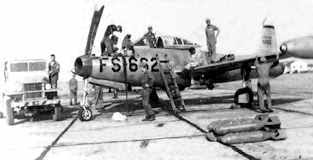
The only photo which has been located which showed Matagorda Island AFB while in use is a circa 1950s/60s picture, captioned “Engineering personnel perform maintenance on the F-84G at Matagorda Island”, from “The Story of the 184th/127th Kansas Air National Guard, 1941-86" (courtesy of Todd Greenberg).
The Matagorda Island Bombing Range was controlled at one time or another by Foster Field, Randolph AFB, Carswell AFB, Bergstrom AFB, Chennault AFB, and Barksdale AFB. The runways at Matagorda Island were apparently doubled in length at some point between 1949-64.
Matagorda Island AFB was depicted as an active airfield on the 1964 San Antonio Sectional Chart (courtesy of Bill Suffa). It was depicted as having a total of 6 paved runways (the longest being 8,000'), its own control tower, VOR beacon, and NDB beacon.
The airfield was reactivated as an Air Force Base for the Strategic Air Command in 1949. Matagorda Island AFB was deactivated in 1975. The property is now a federal wildlife refuge; the airfield is completely abandoned.” More at: http://www.airfields-freeman.com/TX/Airfields_TX_Corpus_NE.html#matagorda
“For several years, beginning in 1942, a portion of Matagorda Island was used for practice bombing by the U.S. Air Force. The 7,325-acre area has largely returned to its natural state as a haven for migratory water fowl and deer.”
__________
On This Day:
FDR takes United States off gold standard, Jun 5, 1933:
“On June 5, 1933, the United States went off the gold standard, a monetary system in which currency is backed by gold, when Congress enacted a joint resolution nullifying the right of creditors to demand payment in gold. The United States had been on a gold standard since 1879, except for an embargo on gold exports during World War I, but bank failures during the Great Depression of the 1930s frightened the public into hoarding gold, making the policy untenable.
Soon after taking office in March 1933, Roosevelt declared a nationwide bank moratorium in order to prevent a run on the banks by consumers lacking confidence in the economy. He also forbade banks to pay out gold or to export it. According to Keynesian economic theory, one of the best ways to fight off an economic downturn is to inflate the money supply. And increasing the amount of gold held by the Federal Reserve would in turn increase its power to inflate the money supply. Facing similar pressures, Britain had dropped the gold standard in 1931, and Roosevelt had taken note.
On April 5, 1933, Roosevelt ordered all gold coins and gold certificates in denominations of more than $100 turned in for other money. It required all persons to deliver all gold coin, gold bullion and gold certificates owned by them to the Federal Reserve by May 1 for the set price of $20.67 per ounce. By May 10, the government had taken in $300 million of gold coin and $470 million of gold certificates. Two months later, a joint resolution of Congress abrogated the gold clauses in many public and private obligations that required the debtor to repay the creditor in gold dollars of the same weight and fineness as those borrowed. In 1934, the government price of gold was increased to $35 per ounce, effectively increasing the gold on the Federal Reserve's balance sheets by 69 percent. This increase in assets allowed the Federal Reserve to further inflate the money supply.
The government held the $35 per ounce price until August 15, 1971, when President Richard Nixon announced that the United States would no longer convert dollars to gold at a fixed value, thus completely abandoning the gold standard. In 1974, President Gerald Ford signed legislation that permitted Americans again to own gold bullion.”
______________
Bobby Kennedy is assassinated, Jun 5, 1968:
“Senator Robert Kennedy is shot at the Ambassador Hotel in Los Angeles after winning the California presidential primary. Immediately after he announced to his cheering supporters that the country was ready to end its fractious divisions, Kennedy was shot several times by the 22-year-old Palestinian Sirhan Sirhan. He died a day later.
The summer of 1968 was a tempestuous time in American history. Both the Vietnam War and the anti-war movement were peaking. Martin Luther King Jr. had been assassinated in the spring, igniting riots across the country. In the face of this unrest, President Lyndon B. Johnson decided not to seek a second term in the upcoming presidential election. Robert Kennedy, John's younger brother and former U.S. Attorney General, stepped into this breach and experienced a groundswell of support.
Kennedy was perceived by many to be the only person in American politics capable of uniting the people. He was beloved by the minority community for his integrity and devotion to the civil rights cause. After winning California's primary, Kennedy was in the position to receive the Democratic nomination and face off against Richard Nixon in the general election.
As star athletes Rafer Johnson and Roosevelt Grier accompanied Kennedy out a rear exit of the Ambassador Hotel, Sirhan Sirhan stepped forward with a rolled up campaign poster, hiding his .22 revolver. He was only a foot away when he fired several shots at Kennedy. Grier and Johnson wrestled Sirhan to the ground, but not before five bystanders were wounded.
Sirhan, who was born in Palestine, confessed to the crime at his trial and received a death sentence on March 3, 1969. However, since the California State Supreme Court invalidated all death penalty sentences in 1972, Sirhan has spent the rest of his life in prison. According to the New York Times, he has since said that he believed Kennedy was "instrumental" in the oppression of Palestinians. Hubert Humphrey ended up running for the Democrats in 1968, but lost by a small margin to Nixon.”
______________
Ronald Reagan dies, Jun 5, 2004:
“On this day in 2004, Ronald Wilson Reagan, the 40th president of the United States, dies, after a long struggle with Alzheimer's disease. Reagan, who was also a well-known actor and served as governor of California, was a popular president known for restoring American confidence after the problems of the 1970s and helping to defeat communism.
Although he never became an A-list star, Reagan spent 20 years in Hollywood and appeared in more than 50 films and several television programs. His oft-used nickname as president, The Gipper, came from his turn playing Notre Dame football star George The Gipper Gipp in the 1940 film Knute Rockne: All American.
Known as the Great Communicator, Reagan left the Oval Office as one of the most popular presidents in history, retiring to his much-loved California ranch, Rancho del Cielo. His announcement in 1994 that he had been diagnosed with Alzheimer's disease was greeted with great sadness by many across the country. He wrote, in an open letter to the American people, I now begin the journey that will lead me into the sunset of my life. I know that for America there will always be a bright dawn ahead.
He lived out the rest of his days on the ranch, with his wife Nancy, who remained devoted to him to the end, by his side. He was buried at the Ronald Reagan Presidential Library in Simi Valley, California.”
____________
Yesterday:
Most of the day was spent ‘desk-traveling’ around Matagorda for writing this journal. The time just seems to fly when one is learning and writing about interesting places. Even to the point of being so engrossed as to forget that there is something cooking on the stove, until Bobbiecat, or the smoke alarm remind me! I had been to Matagorda many years ago, but I didn’t know there was so much to see and do in that area.
My late Johnnie and his son-in-law used to go down there often to fish, towing his Boston Whaler. Sometimes he and his son-in-law would go deep-sea fishing with one of the captains. One day he took me to see a little weekend place they were thinking of buying there. But his son-in law, his best buddy, suddenly died of a heart attack, that’s also when Johnnie’s health started to go downhill. Fishing was his favorite sport, other than watching NASCAR.
Jay came up here on his ATV with Maddie, the tiny Yorkie, and I clipped her face a bit, so she could see where she was going. He also paid me most of the money he owed me, so I’ll get rid of that on shopping day!















2 comments:
Matagorda looks to be a wonderful place! Will put it on our Bucket List!!!
~*~*~*~*~*~*~*~*~*~*~*~*~*~*~*~*~*~
Karen and Steve
(Our Blog) RVing: Small House... BIG Backyard
http://kareninthewoods-kareninthewoods.blogspot.com
Love Matagorda, TX. We live here and love it. Spring & Summer much activity to the area with Fisherman coming and going. More shops and eateries are coming to the area. And there is so much history here to learn and see.
Post a Comment